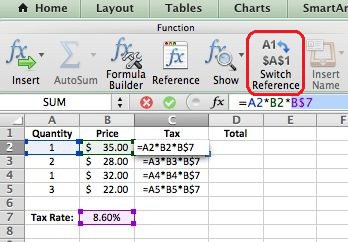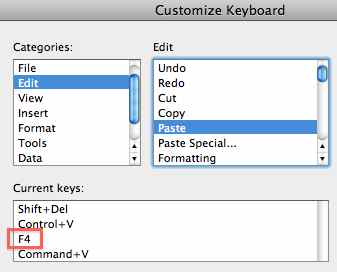Function F4 In Excel For Mac
Is there a repeat function shortcut in Numbers? For instance, if I insert a row and then want to move down a couple of rows and insert another, is there a shortcut key? Or do you have to use the mouse and table menu? In Excel the shortcut is F4. It repeats the last function. It is incredibly useful if you are doing a lot of spreadsheet manipulation. It seems that Numbers is not designed for heavy spreadsheet use, unless I am missing something.
I have been trying to adopt for my accounting work for six months. Everything just seems to take longer than in Excel. I am being patient since I have been an Excel guy for 20 years.
Thanks for your help! I wouldn't say there is anything charming about repeating last function, but as someone who works with spreadsheets all day long I would say it is very useful. For example, if you delete a row. Want to move down a couple rows and delete this row move down and delete that row.etc.

I don't see how to do that quickly. I can't even find a shortcut for doing this much less just repeating what I did a second ago. I am sure I will eventually figure out Numbers, but all my employees are having none of it for productivity issues. Thanks again for your help! Mike, In this particular case, I would go to System Preferences and set an Application Shortcut for Numbers and assign a shortcut for Delete Row.
I just did this and assigned COMMAND-1 to Delete Row and it's a pretty easy combination. Go to System Preference Hardware Keyboard Keyboard Shortcuts. Select Application Shortcuts from the list on the left. Click the plus sign to add a shortcut, in the right pane, select the Numbers Application, type 'Delete Row' in the Menu Title field and type your shortcut into the Keyboard Shortcut field.
Michael2599 wrote: Is there a repeat function shortcut in Numbers? For instance, if I insert a row and then want to move down a couple of rows and insert another, is there a shortcut key? Or do you have to use the mouse and table menu?
Hi Michael, Although I can see where 'repeat action' might be a useful addition in some cases, 'Insert row' is not one of them. Insert row may already be accomplished with a simple key combination—option-down arrow (to insert below the selected row) or option-up arrow (to insert above the selected row). Not much would be gained by substituting a 'repeat last action' keyboard command. For your second example, Delete Row, Jerry's suggestion is an example of creating a personal application specific keyboard shortcut. Such a shortcut can be created for any top level menu item for which a shortcut does not already exist, using the method outlined in Jerry's post.
F4 Repeat Function In Excel For Mac

Restriction: you can't use a keypress combination that has already been defined. Regards, Barry. Apple Footer. This site contains user submitted content, comments and opinions and is for informational purposes only. Apple may provide or recommend responses as a possible solution based on the information provided; every potential issue may involve several factors not detailed in the conversations captured in an electronic forum and Apple can therefore provide no guarantee as to the efficacy of any proposed solutions on the community forums.
Apple disclaims any and all liability for the acts, omissions and conduct of any third parties in connection with or related to your use of the site. All postings and use of the content on this site are subject to the.
Most Excel users are familiar with absolute cell references. In a formula or function, if you type a $ sign before the column letter of the reference and/or the row number of the reference, this indicates to Excel that when the formula or function is copied, it should not “adjust” the cell reference.
In Excel for Windows you can type the $ signs yourself as you are entering the formula or function, or you can press function key F4 AFTER you have typed the cell reference to be made absolute. For example, if I was entering =A1.B7 into a cell and wanted to make A1 absolute, I could type =A1 and then press F4. The result of this would be =$A$1. In Excel for Mac, pressing F4 does not make a cell reference absolute. However, there is a shortcut key Command + T.